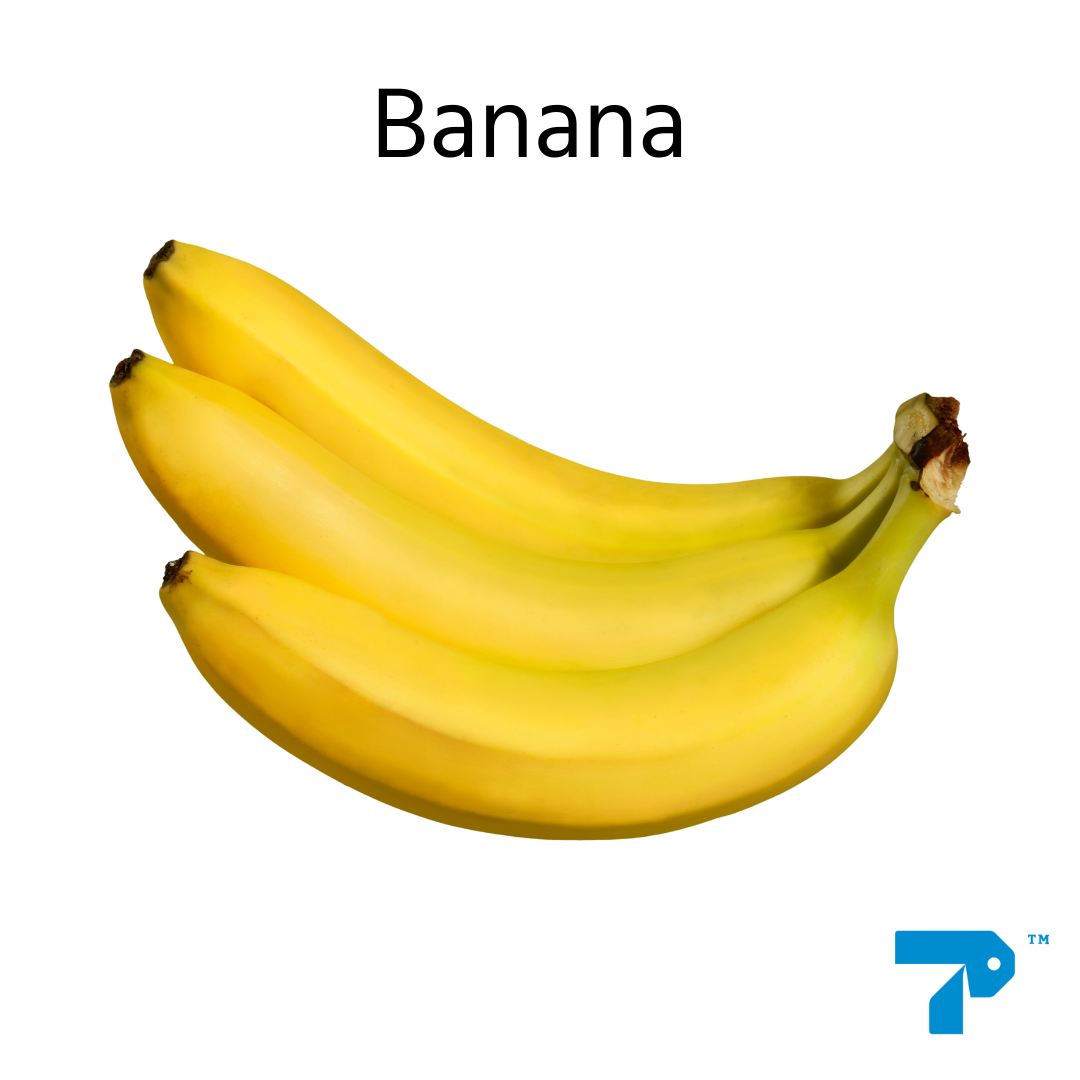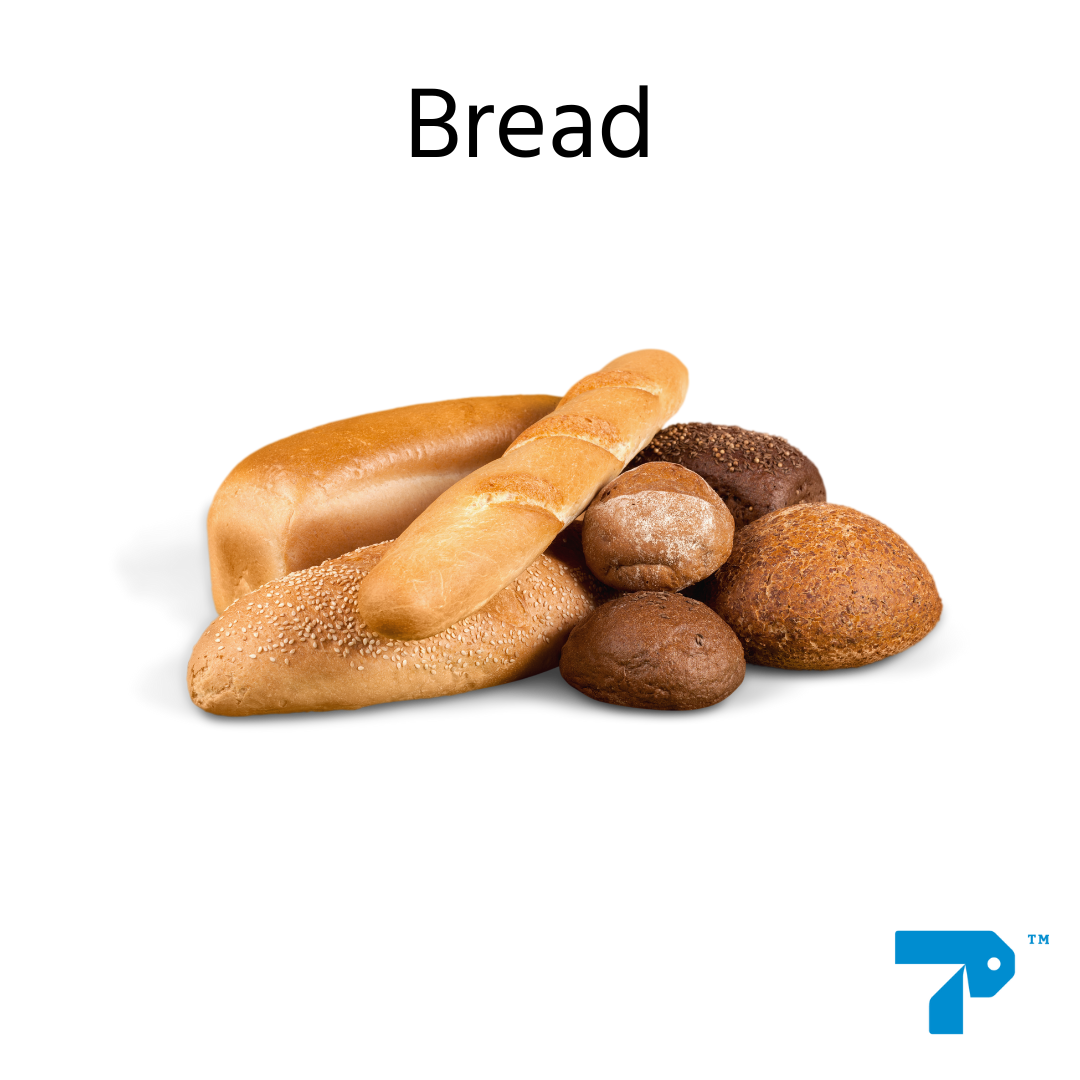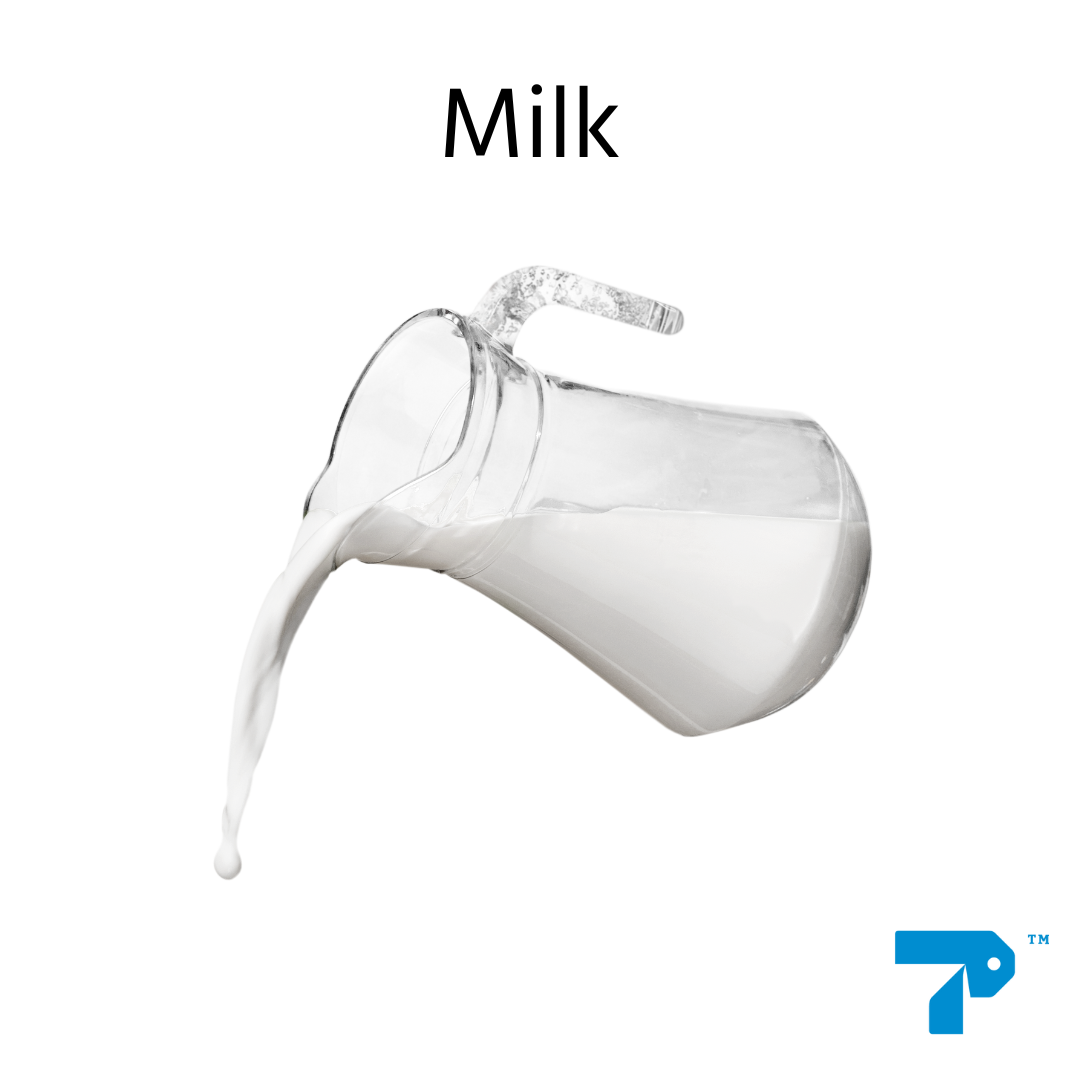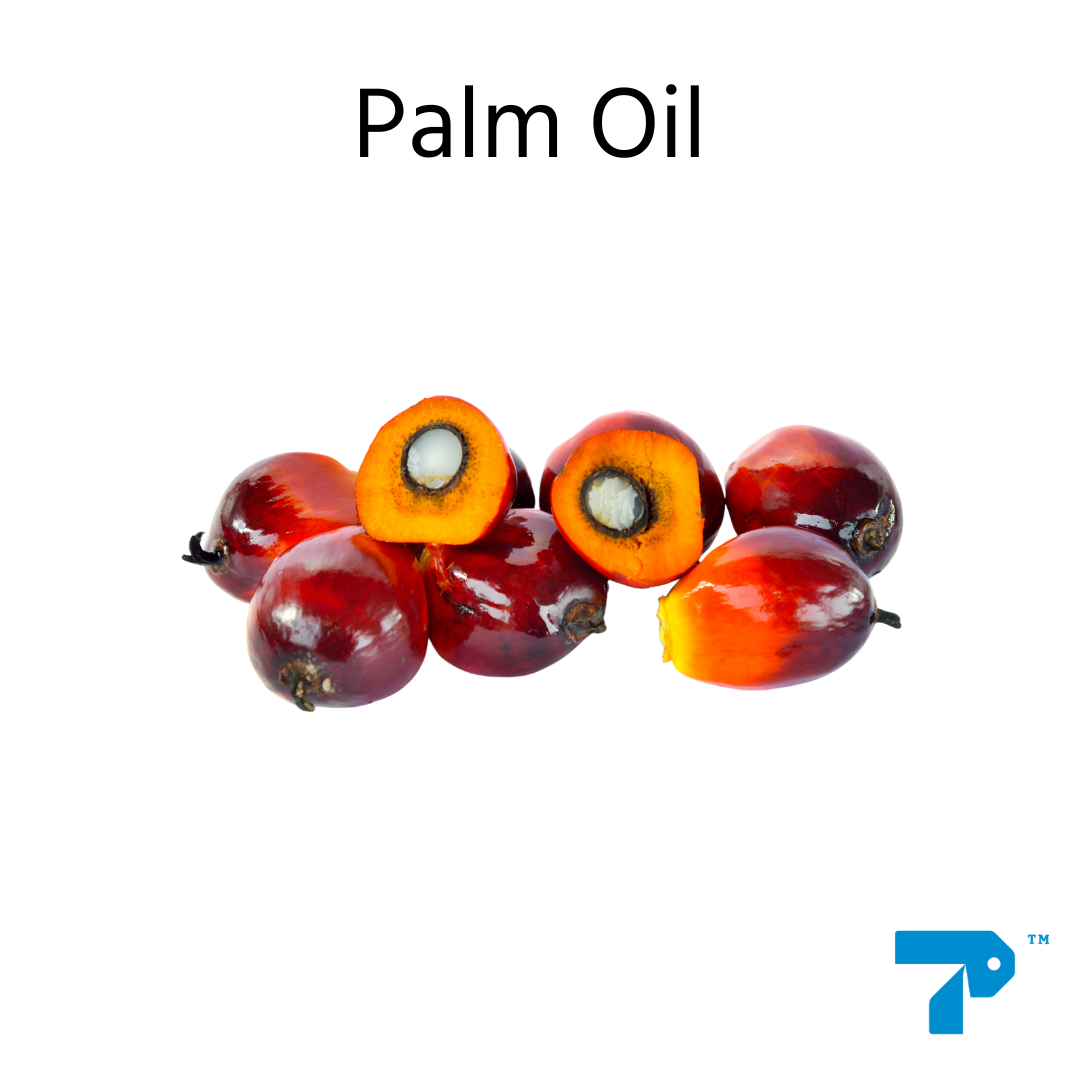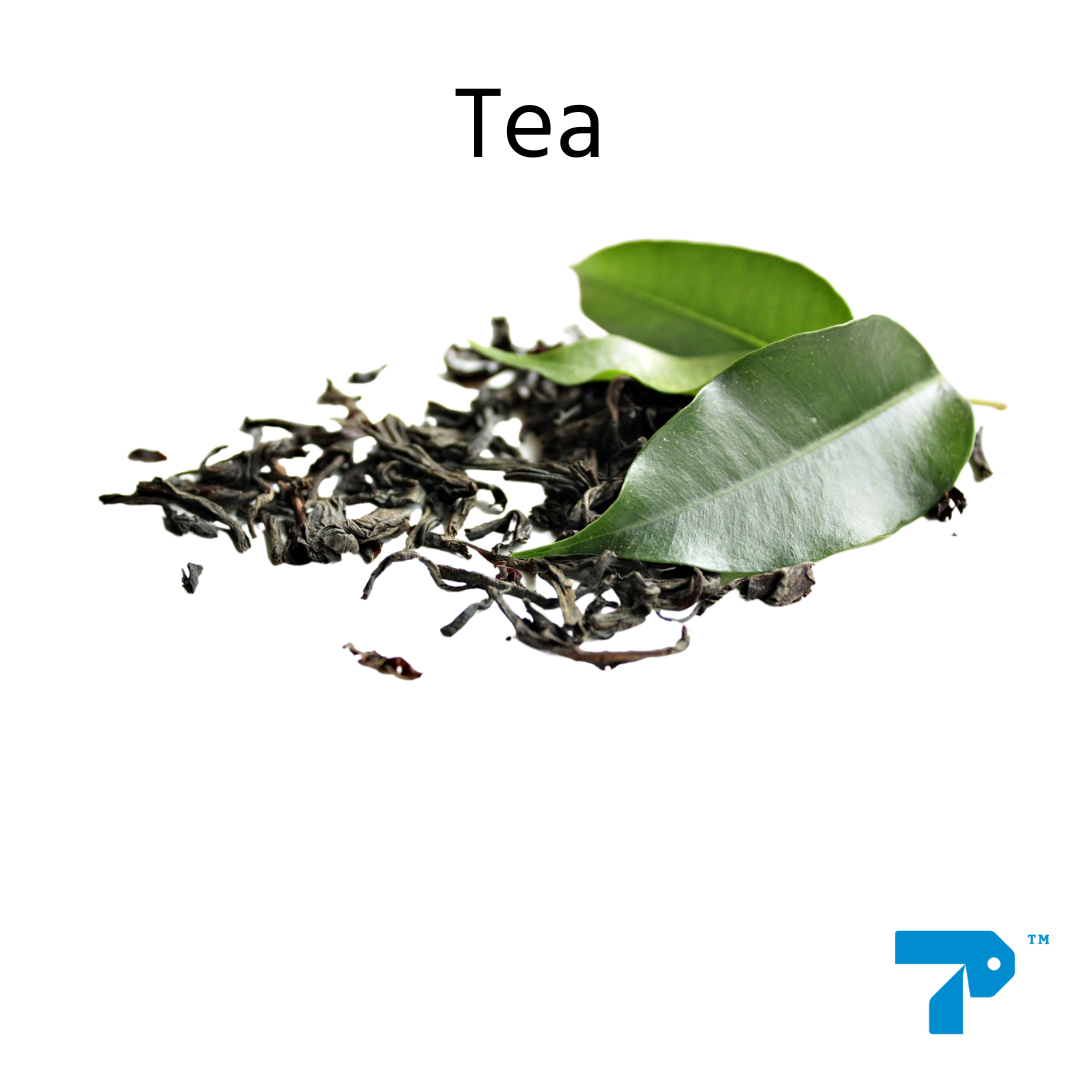True pricing at company restaurants of Vermaat
Vermaat is one of the largest catering and food service companies in the Netherlands and a leader in true pricing. In 2022, Vermaat conducted a three-month pilot project in 13 company restaurants across the Netherlands to test true pricing. The goal was to gain experience and understand how true pricing can add value to their sustainability efforts. The pilot focused on three popular products: a boiled egg, a croissant, and a glass of skimmed milk. Based on the success of this initiative, Vermaat has decided to launch a new true pricing project in 2024, expanding to include more locations, products, and ingredients, aiming for a more comprehensive implementation of true pricing in their operations.
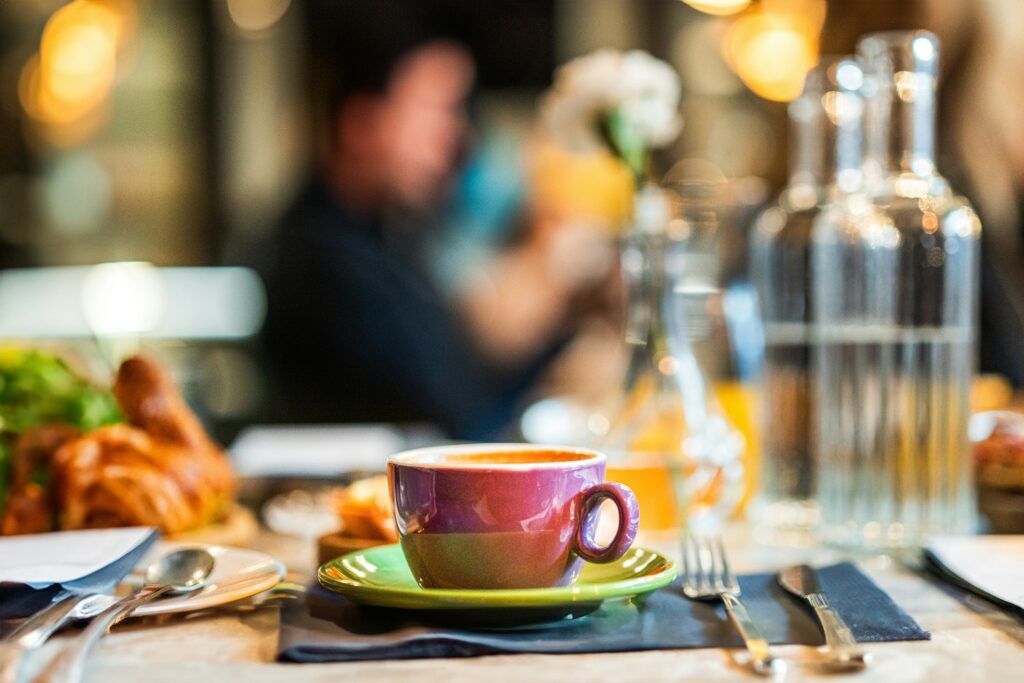

About the new project
Vermaat aims to support a sustainable future by reducing its environmental footprint, minimizing food waste, and contributing to the protein transition. True pricing is seen as a key tool in achieving these sustainability goals. Following the successful pilot in 2022, Vermaat is expanding the true pricing project to include a range of products such as tuna sandwich, vegetarian sandwich, a vegetarian and beef kroket, and coffee with cow milk and oat milk. This initiative aims to provide deeper insights into the true cost of food, helping Vermaat refine its sustainability practices and align with its long-term ambition to integrate true pricing into as specified on its Food Vision 2027 (click here for more information). On this page, you will find all relevant information about the true price gap calculations. This page is intended for visitors of the participating company restaurants and other interested parties.
Products
We have supported Vermaat in calculating the social and environmental externalities (true price gap) of 11 distinct products — encompassing 35 ingredients!
The analysis on this webpage provides insights on three product comparisons: tuna sandwich versus vegetarian sandwich, vegetarian versus beef kroket, and cow’s milk versus oat milk cappuccino. A product choice such as the tuna sandwich is highly relevant, as the Visbureau reported that in 2022, the average Dutch person consumed 9.5 kilos of fish, with tuna being one of the top five (Visbureau, 2022). This statistic not only exceeds that of the previous year but also indicates a growing trend in fish consumption, making it highly relevant from both a supplier and true price perspective.
This section highlights the true price gap results and analysis for each type of impact (social and environmental). We emphasize the differences between what are typically viewed as more sustainable and less sustainable options, followed by an analysis of ingredients with the highest materiality and a detailed examination of the product-specific results.
Approach
How did we estimate the true price gaps?
The true price gaps are based on the True Price Assessment Method. The following timeline briefly explain our methodology:
First Step: Initial Assessment
True Price team looks at the whole supply chain of each ingredients to assess the possible social and environmental externalities.
Second step: Scope
The scope of the assessment is defined. For this project the scope was based on materiality and feasibility assessment. All scoping considerations have been discussed and aligned with Vermaat.
Third step: Footprint measurement
The externalities within the determined scope of the project are analyzed through two phases. First, the footprint indicators are measured. What does this mean? Let's take water use as an example. Calculating this footprint indicator means finding out for each ingredients of a product how many liters of water were used in its production. For more information on the impacts taken into consideration, check out the table below!
Fourth Step: Monetization
Once the footprint for each impact is calculated, it is time to bring it all together. Keep in mind that each footprint indicator is estimated in different measurements. For instance, water use is measured in liters, while land use in hectares. Here's where monetization comes into play. Each footprint measurement is given a value in money. For instance, each liter of water use is calculated to have a specific monetary value. Click the button below to learn more about True Price monetization method!
Read MoreFifth step: The True Price
Finally, all the data is used to calculate the True Price! The True Price of a product is its market price plus its true price gap. Let's sum up how to obtain the true price gap: for each ingredient of a product the different footprints are measured and then monetized. This leaves us with a True Price that accounts for the externalities related to a product!
Data and Scope

Value Chain Steps
The estimates cover material parts of the value chain per ingredient
- Raw materials for cultivation
- Cultivation (on farm)

Impacts
The estimates cover 8 material social and environmental impacts
- Contribution to climate change
- Water use
- Water pollution
- Land use
- Air pollution
- Use of scarce materials
- Poverty (underpayment and underearning)
- Child labour

Data
The results represent national average true price gaps of the products, based on:
- International footprint databases
- True Price monetisations factors
- Limited primary data
As with all research, the results have limitations. Feel free to check them here.
Results
Tables below outline the true price gap estimates for the products included in the project. They do not reflect the exact suppliers of Vermaat but rather provide a high-level estimate of the social and environmental costs of the ingredients supply chains and respective countries of origin. The product with the highest true price gap was found to be the tuna sandwich (find the detailed cost-per-ingredient breakdown below).
Overview of results
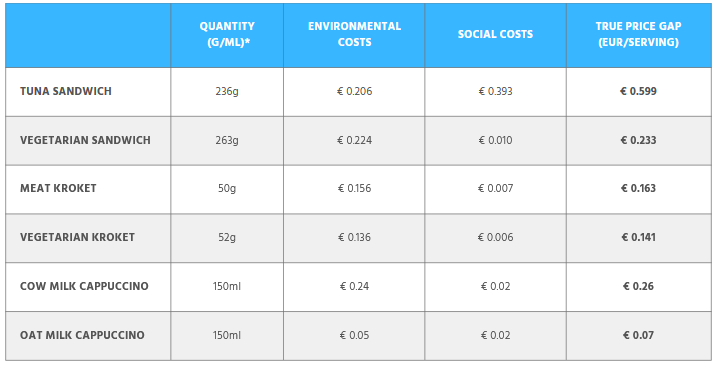
Comparisons
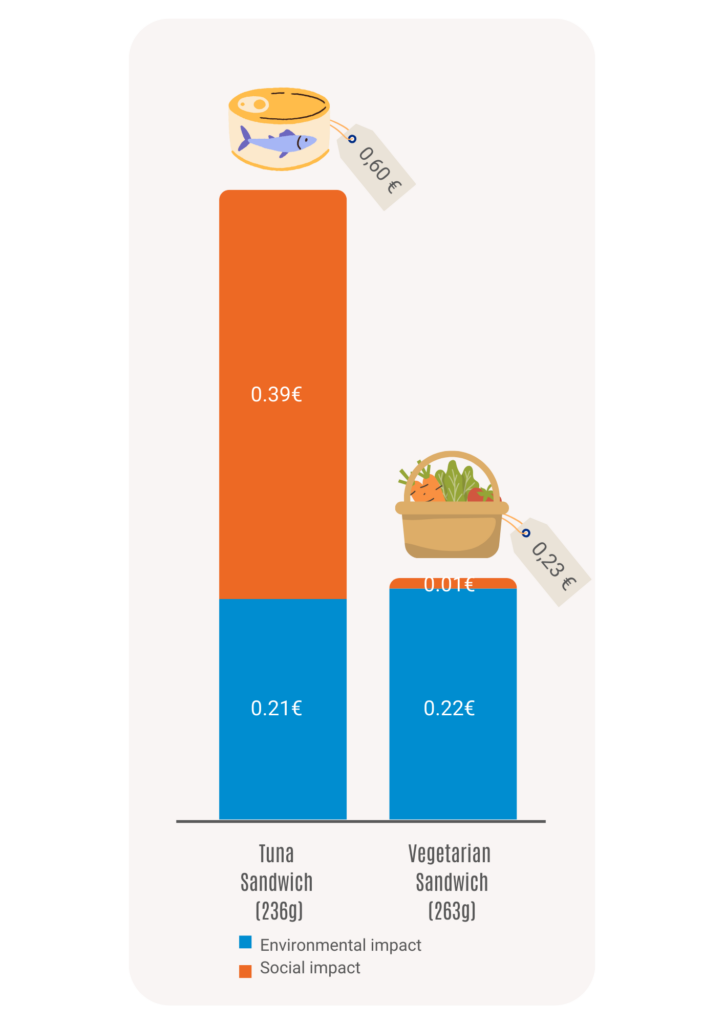
Tuna and vegetarian sandwich
The social costs for the tuna sandwich are predominantly driven by underpayment (46%) and child labour (19%). These issues are linked to the sourcing origin of the tuna from the Maldives (South Asia data used as a proxy), various industries (Najeeb, 2011; Bentz & Carsignol, 2021), and verbal share agreements, rather than written contracts, are common practice, posing a greater risk of labour violations (Tindall et al., 2022) . Environmental costs for the tuna sandwich are primarily due to air pollution (30%) and land occupation (40%), with significant contributions from carbon emissions during vessel use and sunflower oil production.
While child labour and unemployment are also the largest contributors to the social costs of the vegetarian sandwich’s, the total social costs amount to a relatively small sum of €0.01, due to most ingredients being sourced from the EU/US. Regarding environmental costs, air pollution (29%) and land occupation (34%) also dominate as primary costs, mainly due to the impact of red peppers and olive oil. Using olive oil instead of sunflower oil significantly increased environmental costs, making the vegetarian option a less environmentally viable option overall.
Meat and vegetarian kroket
The social costs for the beef kroket are mainly due to underpayment (60%) and child labor (34%). Most ingredients for the beef kroket are sourced from the EU/US, resulting in relatively low social costs. However, this project focuses on farm-level impacts, excluding other stages such as meat packaging. Environmental costs are primarily driven by contributions to climate change (37%) and land occupation (35%). Beef, although only 20% of the total ingredients, accounts for about 80% of the true price gap due to its significant land use and feed requirements.
For the vegetarian kroket, underpayment (59%) is the main social cost. Both types of kroket contain palm oil, and its underpayment impact is not included, potentially underestimating the social costs. Environmental costs are dominated by air pollution (35%) and land occupation (36%), mainly from ingredients like dehydrated egg whites, which significantly increase air pollution and land use due to chicken farming. As a result, the vegetarian kroket has a higher air pollution impact compared to the beef kroket.
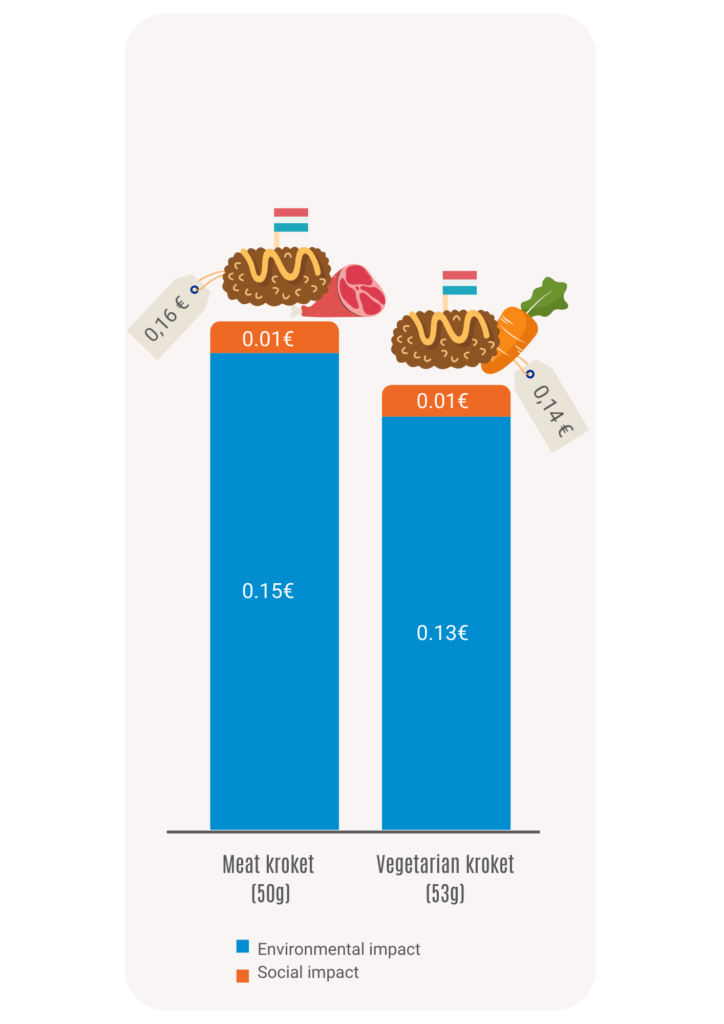
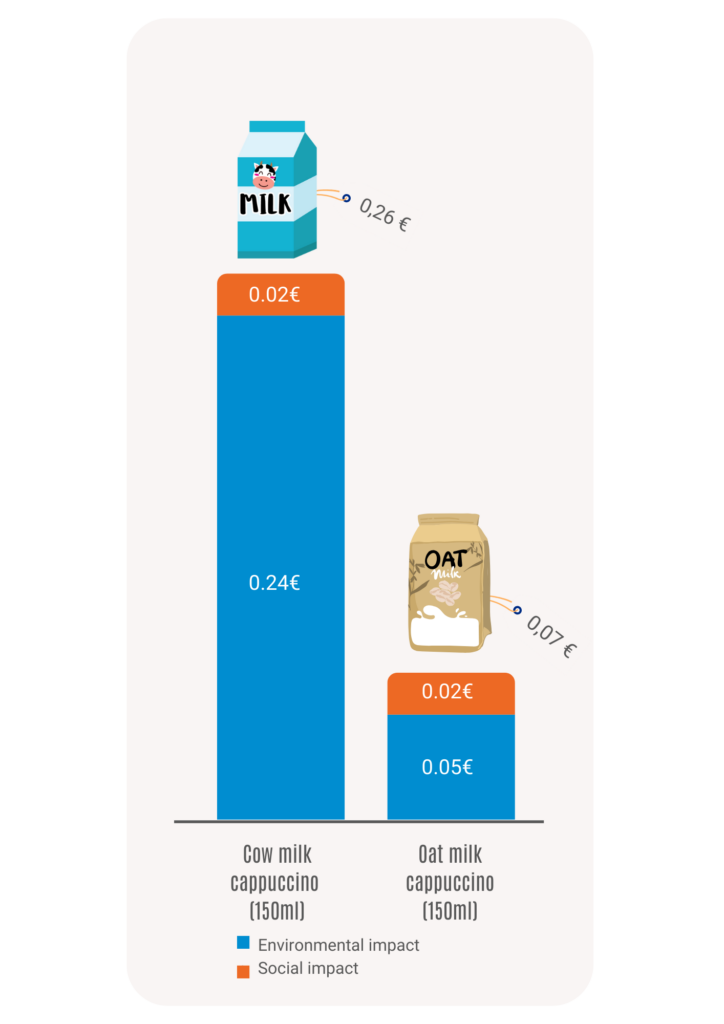
Cow milk and oat milk cappuccino
The primary social cost driver for both cappuccinos is underpayment. For the cow milk cappuccino, underpayment (41%) stems mainly from smallholder coffee farmers. Secondary data indicate that Honduras has the most significant gap in living income for coffee farmers. Environmental costs for the cow milk cappuccino are mainly due to air pollution (55%) and contributions to climate change (21%). The high true price gap for cow milk is linked to its significant environmental impacts, particularly ammonia (NH3) emissions.
Regarding the oat milk cappuccino’s social costs, underpayment (50%) is also the largest contributor, primarily from coffee production. The largest environmental cost contributors for the oat milk cappuccino are land occupation (46%) and contributions to climate change (27%). The production of oat grains, particularly land use, plays a significant role in these environmental impacts.
FAQ
Vegetarian wire meat (dehydrated egg whites), significantly increases air pollution and land occupation due to chicken farming for egg production. Consequently, the vegetarian kroket has a great air pollution impact, even larger than the beef alternative.
Beef production leads to a really high contribution to climate change, land use, and air pollution.
Good to know...
Review process
The project has followed a carefull and standardised review process. All results, data sources, and insights have been validated by independent impact professionals of True Price and the parties involved.
Limitations of the results
The results are based on secondary data(bases), product averages, and a number of assumptions. Moreover, a number of value chain steps and impacts are not in scope. Therefore, the results do not represent the complete true price gap of the products, nor the true price gap of the specific suppliers of Vermaat, and a limited margin of error should be taken into account. We advice caution and restraint in communicating and using the results to prevent confusion, miscommunication and misinterpretation
Vermaat and true pricing
Vermaat is a leading hospitality company in the Netherlands, specializing in tailor-made food and beverage solutions. Founded in 1978, Vermaat has grown to operate over 350 locations, including company restaurants, museums, hospitals, and airports. The company is dedicated to sustainability, innovation, and quality, focusing on reducing its environmental footprint and enhancing customer experiences. Vermaat collaborates with a wide range of partners to create unique culinary concepts that cater to diverse audiences while promoting responsible sourcing and sustainable practices.
For more information, visit Vermaat’s website.
Vermaat adopted true pricing to address the hidden costs in product pricing, such as environmental damage, CO2 emissions, and unfair labor practices. This approach helps Vermaat identify critical issues within their value chain, including child labor and water pollution. By understanding the specific impacts of different ingredients, Vermaat can adjust their suppliers and practices to be more socially just and environmentally sustainable. True pricing enables Vermaat to promote a fairer system and make sustainable production the norm, fostering greater accountability and transparency in their operations.
Vermaat developed a remediation strategy and selected three organizations to transfer the True Price funds: Solidaridad, Good Fish, and Land van Ons. Each location of Vermaat can choose one or more of these three organizations as their remediation partner. As Vermaat is looking to contribute as well to reducing social and environmental externalities, not only customers are invited to pay the true price of their products, but Vermaat also donates 10% on top of each true price gap paid to the remediation partners.
Contact us for more information
In the media
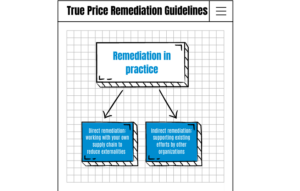
True price payments, why and how?
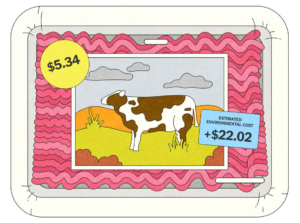
True Price Celebrates New York Times Feature Highlighting the Importance of True Pricing in Building a Sustainable Future
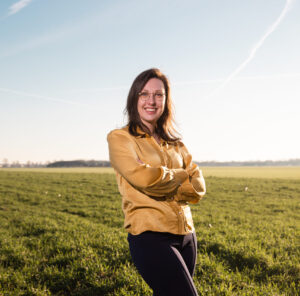
True Price in Action: Pauline Rosenberg’s insights from Vermaat’s Sustainability Journey
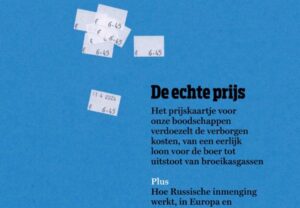
True Price featured in De Groene Amsterdammer

Announcing True Price attracts Managing Director Claire van den Broek

True Price featured in FashionUnited
